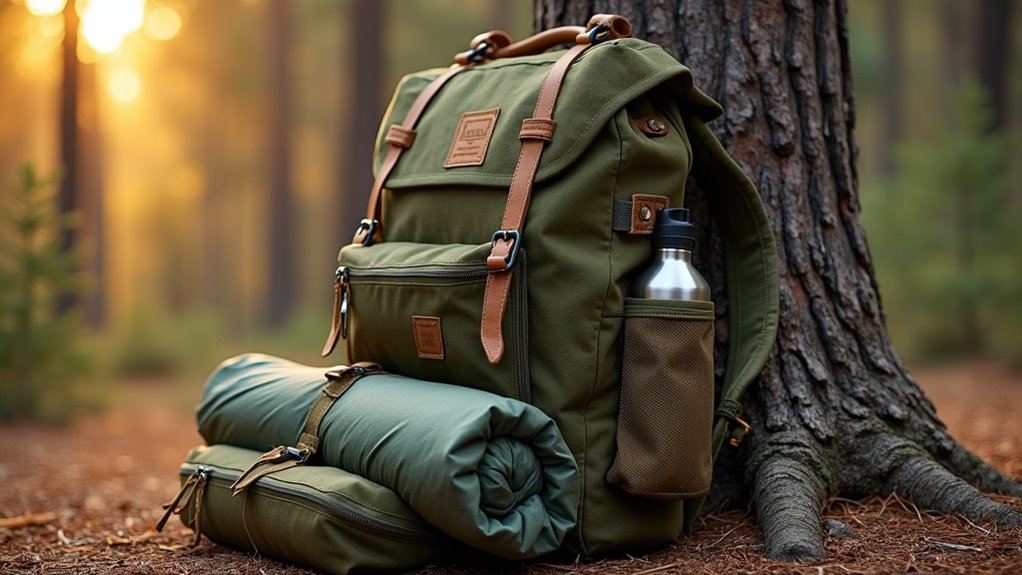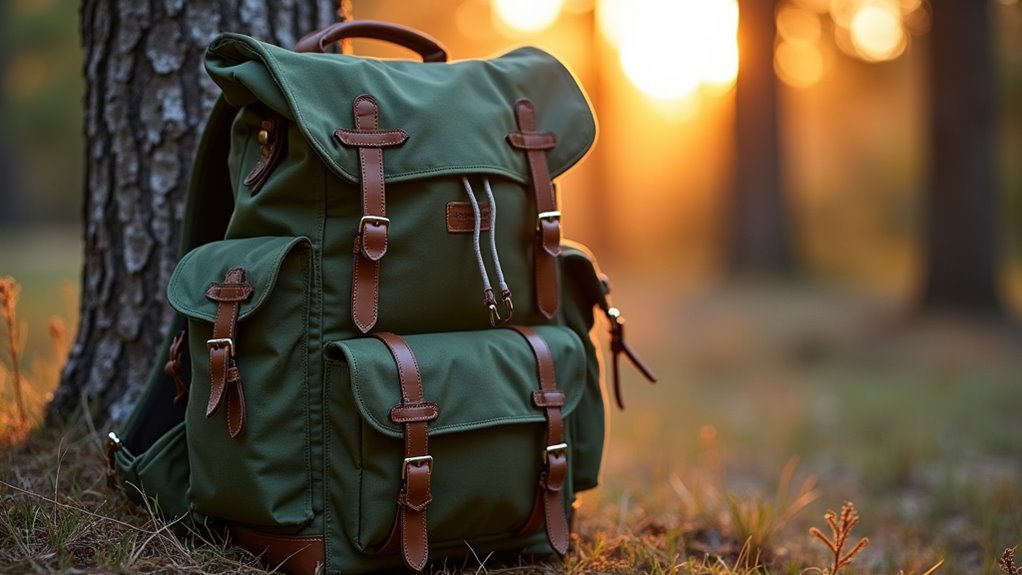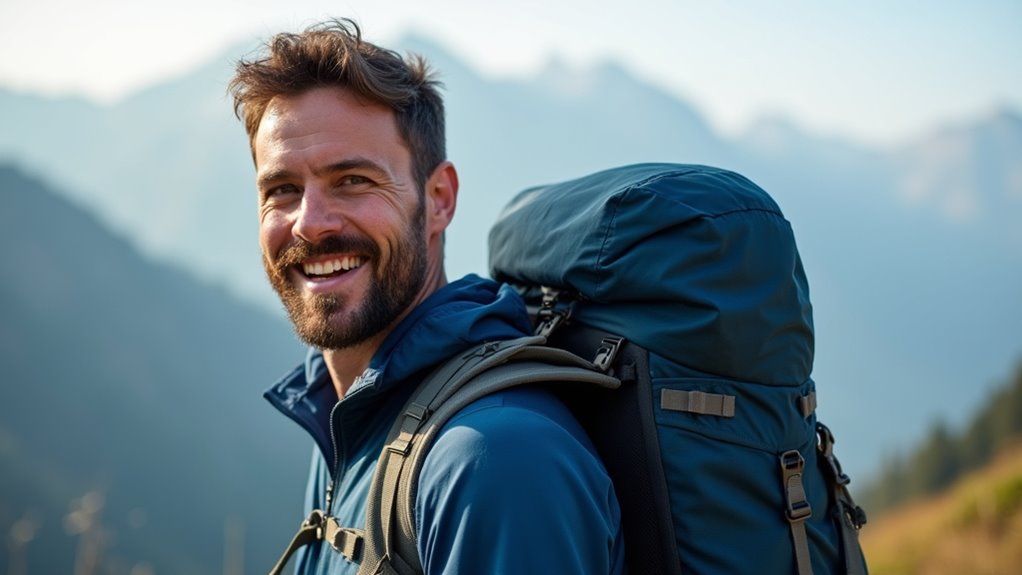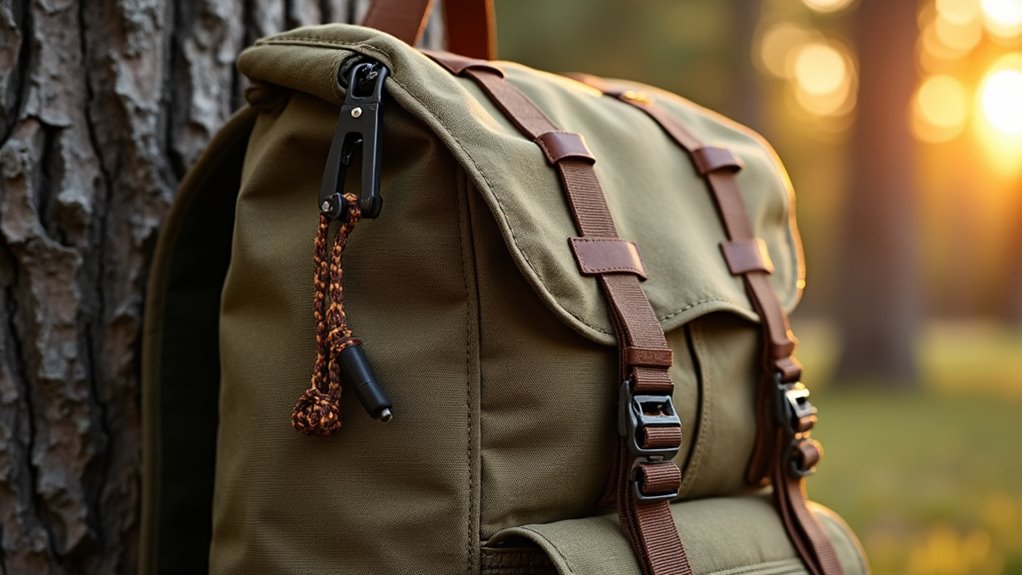Physical Address
304 North Cardinal St.
Dorchester Center, MA 02124
Physical Address
304 North Cardinal St.
Dorchester Center, MA 02124

How choosing the right men's camping backpack can transform your outdoor adventure from a grueling ordeal into an unforgettable experience.
When you’re planning your next camping adventure, don’t underestimate the importance of a proper backpack. You’ll find that a quality pack can make or break your outdoor experience, affecting everything from your comfort to your ability to carry essential gear. While budget-friendly options exist, investing in the right backpack will serve you well beyond a single trip. Let’s explore what makes a men’s camping backpack truly worth your investment.

When it comes to camping, having a quality backpack isn’t just a luxury – it’s essential for any male outdoor enthusiast.
With over 77% of backpack users being men and 54% preferring backcountry camping, you’ll need reliable gear that can handle rugged conditions. Essential camping gear is crucial for a successful trip.
Backcountry camping demands tough, dependable gear – especially for the majority of male adventurers who venture into challenging wilderness terrain.
Your pack serves as your lifeline in the wilderness, carrying everything from shelter to sustenance.
If you’re among the growing number of men seeking challenging outdoor experiences, you’ll appreciate how a well-designed backpack distributes weight properly and prevents strain during long treks.
Whether you choose an internal frame for ergonomic comfort or an external frame for heavy loads, investing in quality pays off.
The growing demand for hiking and camping gear is evident, with the U.S. backpack market expected to reach USD 10.25 billion by 2032.
Five core features separate a reliable camping backpack from a basic daypack.
You’ll want adequate pack size – choose 20-35 liters for day trips or 40-70 liters for longer adventures. Internal frame packs provide the best stability and body-hugging comfort for heavy loads during extended hikes. Essential Camping Gear should be carefully selected to ensure a successful outdoor adventure.
Look for ventilation features like suspended mesh back panels and air channels to keep you cool on challenging trails.
Smart storage options are essential – multiple compartments, external attachment points, and a dedicated sleeping bag space will organize your gear efficiently.
Don’t overlook hydration compatibility – an internal sleeve for your water reservoir with tube outlets makes staying hydrated hassle-free.
Finally, invest in durability – high-denier fabrics with water-resistant coatings and reinforced stitching will protect your gear through rough conditions.
While quality packs might cost more upfront, they’ll save you money by lasting longer and performing better on the trail.

Understanding backpack frame types can make or break your camping experience, as each design serves distinct purposes on the trail.
You should aim to match your frame choice to your adventure style and budget. Essential camping gear can also impact your backpack selection.
Choosing the appropriate backpack capacity serves as one of the most crucial decisions you’ll need to make for your camping adventures.
For day hikes, stick to 10-30 liters – you’ll only need room for essentials like water, snacks, and basic safety gear. A helpful way to visualize capacity is to think in terms of Nalgene bottle sizes.
Planning an overnight stay? A 20-40 liter pack will comfortably fit your sleeping bag and basic camp setup. When choosing kids camping gear, consider lighter materials and adjustable features to ensure a comfortable fit for your little adventurers.
A 20-40 liter backpack provides the perfect capacity for single-night adventures, accommodating essential sleep gear and camping basics.
Weekend warriors should opt for 50-65 liter packs, giving you space for extra clothing and food without going overboard.
For extended trips lasting five days or more, you should consider investing in a 70-90 liter pack to accommodate additional supplies and weather gear.
If you’re heading into technical terrain or leading group expeditions, consider 90+ liter packs – they’re built to handle specialized equipment and extended periods without resupply.

While finding the perfect backpack can seem intimidating, proper fit and comfort should be your top priorities when selecting a pack for camping trips. Your torso length, not height, determines the right size – typically ranging from 16 to 21 inches for men. Testing revealed that multiple brand options from Osprey, Granite Gear, Gregory, and REI provide excellent sizing flexibility for different body types.
You should aim to confirm proper alignment of shoulder straps and hip belts with your body’s frame. Essential camping gear can help make your trip more comfortable and enjoyable.
Proper storage and organization of camping gear can make or break your outdoor experience, both at home and on the trail. You’ll save time and money by investing in clear, durable containers that protect your equipment from moisture and pests while keeping items visible and accessible.
Maximize your storage space by utilizing vertical solutions. Mount racks and hooks on walls to keep larger items off the floor, and opt for stackable bins that adapt to your growing collection. Use hanging storage solutions to efficiently utilize closet space.
Group your gear by function – keep your shelter system, cooking equipment, and clothing in separate containers. Essential camping storage solutions can ensure your next adventure is a success.
Don’t forget to label everything and maintain a checklist system. Store your gear clean and dry, and perform regular inspections for damage.
This organized approach will make packing efficient and guarantee you’re always ready for your next adventure.

Now that you’ve got your gear well-organized, let’s focus on the durability features that’ll protect your investment for years to come.
When choosing a camping backpack, you should pay close attention to construction quality that’ll withstand rough outdoor conditions while keeping your gear safe and dry.
Regular care and maintenance of your backpack, including gentle cleaning and prompt repairs, will significantly extend its lifespan and reliability.
Recent innovations in camping backpacks have transformed how you’ll experience the trail, with groundbreaking materials and smart design features that won’t break the bank.
You’ll find ultralight materials like UltraGrid 200d RipStop that cut weight without sacrificing durability. Roll-top closures now offer better weather protection, while frameless designs with stabilizing straps provide comfort without excess bulk.
Many packs feature breathable padding and ergonomic harnesses that distribute weight evenly across your body. Look for packs with built-in electronics integration, zippered hipbelt pockets for quick access to essentials, and multiple attachment points for your gear. The highly-rated Gregory Paragon 58 represents the perfect balance of features and comfort.
Today’s backpacks also emphasize sustainability with recycled materials and customizable features like removable components. These innovations mean you can choose a pack that perfectly matches your camping style and budget. On top of that, essential camping gear is crucial for a successful outdoor adventure.
Like a trusty sherpa scaling Everest, your camping backpack‘s the key to conquering the wilderness without breaking the bank. You’ll find that investing in a well-fitted pack with smart storage pays off mile after mile. Don’t skimp on quality – choose a durable companion that’ll weather storms like a lighthouse in rough seas. With the right backpack, you’re ready to blaze trails and create unforgettable outdoor memories.